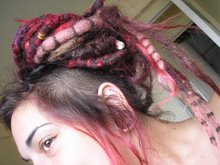Dread Care FAQ
Washing
It’s best not to get wool wet, so try to only wash your hair when you feel it really needs it. You can tie your hair up or use a shower cap to keep it dry during normal showering. Try to limit shampooing to once a week at most, less often if you can stand it! If you are accustomed to shampooing daily, your hair (and you) may take a little while to adjust to less frequent washing, but the hair’s oil production will adjust accordingly. Using a clean-rinsing, residue-free shampoo, (try something with tea tree oil or oil of peppermint), make a diluted solution of two parts shampoo to one part water. Apply shampoo just the scalp area, holding the wool out of the way. There is no reason to shampoo the wool parts unless they become really dirty or smell really funky (like smoke). If you do have to wash them at some point, use cold water to limit shrinkage and colour fading, and be very, very gentle, taking care not to pull them, as wool becomes more fragile when wet. Always make sure to rinse really well. Never use conditioner, as it can cause loosening, and avoid other products that might leave residues in the hair.
Wool gets super heavy when it’s wet, so to dry your hair, squeeze as much water out as possible and then squeeze again inside of a towel. For long hair, to avoid damaging the hair, support the weight of the wool with your hands to reduce any pulling or stress on your neck and scalp. After squeezing, try flipping your head over, wrapping your hair in a towel, twisting, and wrapping it up like a turban. Leave it up for five or ten minutes to dry, then carefully untwist it and squeeze again in a dry towel. Leave your hair down and loose until it is completely dry. Avoid going to bed with wet hair. It’s best to wash your hair on a hot, dry, windy, sunny day, as it will dry faster. The wool can be palm-rolled and reshaped if it has warped or shrunken from washing.
The Itchies
It is not uncommon for people to experience “the itchies,” especially the first few days to a week after installing extensions. This is simply the hair getting used to being part of a dreadlock or braid and/or carrying more weight, as in the case of extensions and wraps, and should go away once the hair relaxes. Try not to scratch the scalp, as it may cause further irritation, damage the hair and cause fuzzies, or even loosen the extensions. Shampoos containing tea tree oil or peppermint oil can have a nice, cooling effect and have astringent properties that help with itchies. Some people use special shampoos meant for dandruff and itchy scalp. It is best to use a clean-rinsing, unscented shampoo that won’t leave residues in your dreads, because those too can cause itchies. Always rinse really well. Braid spray can help with persistent itchies, and in severe cases, an antihistamine might be used.
*disclaimer - dreads cannot be returned or exchanged once worn*

